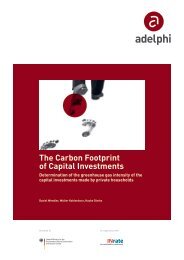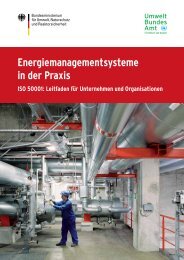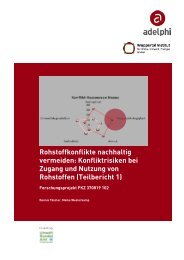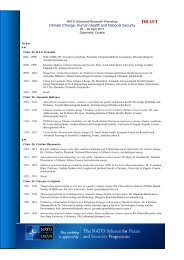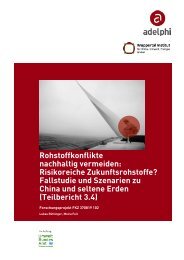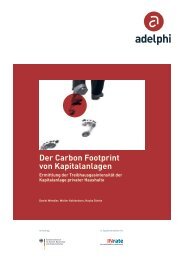DIN EN 16001: Energy Management Systems in Practice - adelphi
DIN EN 16001: Energy Management Systems in Practice - adelphi
DIN EN 16001: Energy Management Systems in Practice - adelphi
You also want an ePaper? Increase the reach of your titles
YUMPU automatically turns print PDFs into web optimized ePapers that Google loves.
64<br />
5. Internal audits<br />
You must regularly carry out <strong>in</strong>ternal audits, 27 which<br />
<strong>in</strong>cludes a systematic review of your EnMS. Internal<br />
audits are an important step for cont<strong>in</strong>uous improvement.<br />
In the run-up to an <strong>in</strong>ternal audit, it is advisable to<br />
clarify what it actually conta<strong>in</strong>s. For <strong>in</strong>stance, it should<br />
not be taken as a:<br />
•<br />
Cost-benefit-calculation of <strong>in</strong>dividual measures<br />
• Calculation of economic efficiency for future<br />
projects<br />
• Analysis of technical aspects of the equipment<br />
purchased accord<strong>in</strong>g to the action plan<br />
The aim of the <strong>in</strong>ternal audit is to further improve the<br />
functionality of your EnMS, your energy management<br />
Tip<br />
27 Def<strong>in</strong>ition accord<strong>in</strong>g to <strong>DIN</strong> <strong>EN</strong> <strong>16001</strong>: “The purpose of an <strong>in</strong>ternal audit is to carry out a systematic review of the energy management system and<br />
assess whether the system operates <strong>in</strong> accordance with the organization’s own requirements together with those of the energy management system<br />
standard.”<br />
28 ISO 19011, which at the moment is <strong>in</strong> the process of be<strong>in</strong>g amended, is the <strong>in</strong>ternational audit standard. It functions as a guide for audit<strong>in</strong>g quality<br />
and environment management systems and lists the qualifications of auditors.<br />
programmes, objectives and targets etc. and to help<br />
develop new measures for optimis<strong>in</strong>g your energy<br />
management. 28 An audit is a systematic element of the<br />
<strong>in</strong>ternal review of your EnMS and thus an important<br />
step for cont<strong>in</strong>uous improvement. Therefore, you<br />
should not see the <strong>in</strong>ternal audit as merely a control<br />
measure but as an opportunity to f urther improve<br />
yourself and the company.<br />
The <strong>in</strong>ternal audit should take place at least once a<br />
year. It can either be conducted by employees of your<br />
company who have the required skills and knowledge<br />
about your EnMS, the standard <strong>DIN</strong> <strong>EN</strong> <strong>16001</strong>, as well<br />
as the aspects to be analysed but rema<strong>in</strong> outside the<br />
direct management of the EnMS. Otherwise, you can<br />
consult an external auditor and have him / her carry it<br />
out. In this case, it is advisable to use the same auditor<br />
that is used for certification as it saves on effort and<br />
costs. In either case, the auditor should be qualified,<br />
experienced, impartial and <strong>in</strong>dependent of the area<br />
to be assessed <strong>in</strong> the organisation.<br />
When conduct<strong>in</strong>g <strong>in</strong>ternal audits through an employee, it is recommended to first<br />
consult the other management officers of your company to exchange advice.<br />
Once you have decided on the auditor, you should<br />
then carefully plan the actual implementation of the<br />
audit. Th<strong>in</strong>k beforehand about which <strong>in</strong>formation<br />
sources you will use. These can be persons, documents<br />
or already exist<strong>in</strong>g energy reports. It is a good idea to<br />
collect the essential data for the <strong>in</strong>ternal audit before<br />
the audit itself. This will help to save time and cost and<br />
will give you a good opportunity to get more deeply<br />
<strong>in</strong>volved <strong>in</strong> the analysis of possible causes. Inform the<br />
relevant persons <strong>in</strong> time and gather background <strong>in</strong>formation<br />
<strong>in</strong> the run-up to the audit.<br />
Prepare audit checklists for guidance dur<strong>in</strong>g the audit.<br />
In Appendix A, you will f<strong>in</strong>d examples of checklists<br />
that will help you analyse the current status quo of<br />
your EnMS. If required, note the type of resources<br />
used, place and time of the audit taken, as well as the<br />
name of the persons responsible.<br />
At the beg<strong>in</strong>n<strong>in</strong>g of the audit, expla<strong>in</strong> the objective of<br />
the <strong>in</strong>ternal audit to all employees directly connected<br />
to the EnMS elements which are to be audited. It is<br />
important that it is not about the performance of the<br />
<strong>in</strong>dividual employee but about the effectiveness of the<br />
EnMS.








